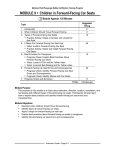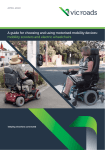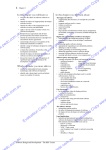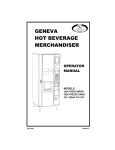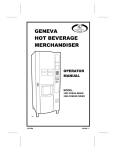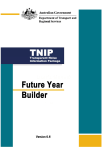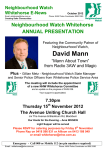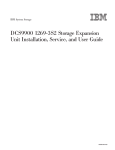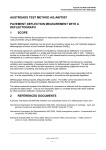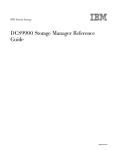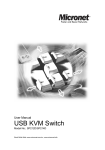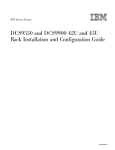Download A simple guide to child restraints - Department of Infrastructure and
Transcript
a simple Guide to child restraints Department of Infrastructure, Transport, Regional Development and Local Government GPO Box 594, Canberra, ACT 2601 Australia Freecall: 1800 026 349 www.infrastructure.gov.au Nov2007/DOTARS 50404 how you can protect your child a guide for parents with children from birth to 16 years cover_file.indd 1 22/07/09 2:57 PM Restraints are important ................................ 1 Pregnancy ......................................................3 Babies............................................................4 Very young children .......................................7 Young children and older children .................9 Tether-strap fittings and anchorages ........... 13 General information ..................................... 15 Further help ................................................. 16 Technical advice courtesy of: NSW Roads and Traffic Authority, RAA of SA Inc, RAC of WA Inc, RACV, RACQ Ltd, NRMA Ltd, RACT, Kidsafe Australia, Britax Photographs courtesy of: VicRoads and Kidsafe Australia Royal Automobile Club of W.A. (Inc) Telephone: 13 17 03 Website: www.racwa.com.au Royal Automobile Club of Queensland Ltd Telephone: (07) 3872 8926 (Brisbane) 1800 816 523 (all other areas) Website: www.racq.com.au Royal Automobile Club of Victoria Telephone: (03) 9790 2190 Website: www.racv.com.au Royal Children’s Hospital Child Health and Safety Resource Centre (Melbourne) Telephone: (03) 9345 5085 Website: www.rch.org.au/chas Victoria Telephone: (02) 9251 7725 Australian Capital Territory Telephone: (02) 6290 2244 New South Wales Telephone: (02) 9845 0890 Further help Contents Automobile Association of N.T. Inc. Telephone: (08) 8981 3837 Website: www.aant.com.au Queensland Telephone: (07) 3854 1829 Tasmania Telephone: (03) 6214 8830 Western Australia Telephone: (08) 9340 8509 1800 802 244 (Child Safety Information Line) Australian Transport Safety Bureau Website: www.atsb.gov.au Information Line Telephone: 1800 621 372 Kidsafe Translating and Interpreting Service (TIS) www.kidsafe.com.au Telephone Interpreting (24-hour service) Telephone: 13 14 50 National office Telephone: (02) 6290 2243 Hunter Valley Region Telephone: (02) 4942 4488 Northern Territory Telephone: (08) 8985 1085 South Australia Telephone: (08) 8161 6318 cover_file.indd 2 22/07/09 2:57 PM Restraints are important Always use restraints when you drive with children. Children can be particularly vulnerable in a car, even when they are sitting in the back seat. When driving with children, ensure that they are always correctly restrained, even when you: » drive slowly » drive carefully » take just a short trip. You must wear a seat belt even when you are pregnant. Children require the appropriate restraint for their size: » infant restraints (for babies – newborn to about 6 months or 12 months) » child seats (for very young children – from about 6 months to 4 years old) » booster seats and harnesses (for young children – from about 4 years old to 10 years old) » seat belts (for older children). Always take the time to get your child comfortably and correctly strapped in. Warning » Each child restraint must be correctly installed and it must have the Standards Australia mark. » Each child restraint must suit your child’s weight and size. Children grow at different rates, so your child’s weight and size are much more important than your child’s age. » Avoid early promotion: do not move your child from one type of restraint to the next before they have reached the top of the weight or height range of the restraint. Children should continue to use a suitable child restraint for as long as they fit. (Continued on next page...) A simple guide to child restraints BOOKLET_larger.indd Sec1:1 1 22/07/09 2:58 PM » Where possible, always place children in the back seat of your car. The back seat is much safer than the front seat. » Never use an infant restraint in the front-passenger seat if your car has a front-passenger airbag. » Do not use a restraint if it is more than 10 years old, is damaged or has been in a crash, even if it does not appear to be damaged. » Child restraints should never be used in vehicle seats that face rearward or sideways. 2 BOOKLET_larger.indd Sec1:2 A simple guide to child restraints 22/07/09 2:58 PM All Australian states and territories require you to wear a seat belt, even when you are pregnant. Pregnant women sometimes find wearing a seat belt uncomfortable, or worry that it may harm the unborn baby. However, a seat belt that is worn properly puts little pressure on your stomach. A seat belt will protect both you and your baby in the event of a crash. Without a seat belt, the risk is much greater for both baby and mother. Pregnancy Pregnancy How should I wear the seat belt? Place the lap (the lower part of the seat belt): » over your upper thighs » across your hips » below your baby. Place the sash (the upper part of the seat belt): » over your shoulder » between your breasts » above your baby. The photograph shows you how to wear the seat belt correctly. A simple guide to child restraints BOOKLET_larger.indd Sec1:3 3 22/07/09 2:58 PM Babies NEWBORN TO ABOUT 6 MONTHS OLD OR 12 MONTHS OLD WEIGHT: UP TO 9 KG (OR 70 CM IN LENGTH) OR 12 KG DEPENDING ON MAXIMUM WEIGHT/LENGTH NOTED ON THE RESTRAINT You should plan to get an infant restraint before your baby is born, and use the restraint to take your baby home from the hospital. The restraint must have the Standards Australia mark (see page 15) and you must install the restraint correctly in your car according to the manufacturer’s instructions. What type of restraint should I get? You can rent or buy several types of infant restraints. Before you select your restraint, ask yourself: » Does it have the Standards Australia mark? » Will it fit in my car? » Will it be easy to use? » If your baby is already several months old, will it suit your baby’s weight and size? There are two kinds of infant restraints: single purpose (only facing rearward) and convertibles. Convertibles face rearward until the baby weighs 9 kg or 12 kg, depending on the specific model (refer to the packaging and manufacturer’s instructions), and are then turned around to face forward. Neither kind should be used in vehicle seats that face rearward or sideways. Your baby should be left in a rearward-facing restraint until the baby reaches the specified weight limit. In that position, the force of any crash is distributed evenly across the baby’s torso, and the back of the infant restraints will support and protect the head and neck. NEVER fit a rearwardfacing infant restraint with an airbag in front of it. 4 BOOKLET_larger.indd Sec1:4 A simple guide to child restraints 22/07/09 2:58 PM In most states and territories, you can rent an infant restraint from: » private companies » community groups » local councils » hospitals. Babies Where can I rent an infant restraint? See pages 16 and 17 for further help. How do I install an infant restraint? You must follow all of the manufacturer’s instructions when you install the infant restraint. Be sure that you understand the correct use of tether straps and anchorages (see page 13). If you have any problems, ask an approved fitting station to help you (see pages 16 and 17). How do I use an infant restraint? Before you use an infant restraint, check that you understand all of the manufacturer’s instructions. Make sure that you have enough room to place your baby in the restraint. If the tether strap is in your way, either: » separate the tether strap from the anchorage; or » extend the connected tether strap until the tether strap is loose. Do not wrap your baby in a blanket or a rug before you place the baby in the restraint. The infant restraint has a harness (safety belt) for your baby. Place the harness straps over your baby’s shoulders and between the legs. The shoulder straps must not be below the baby’s shoulders. Adjust the harness until it fits comfortably yet firmly. If you can fit more than one of your fingers between the straps and your baby, the harness is not tight enough. If you wish, you may now cover your baby with a blanket or a rug. Check that the baby can breathe comfortably. A simple guide to child restraints BOOKLET_larger.indd Sec1:5 5 22/07/09 2:58 PM If you separated the tether strap from the anchorage to make it easier to place the baby in the restraint, remember to connect the tether strap again once the baby is placed in the restraint. If you extended the tether strap in order to make it loose, remember to adjust the tether strap until it is firm. Do not over-tighten. Every time you use the infant restraint, check that the tether strap and the harness are properly connected and firm, and that the seat belt is correctly fitted, engaged and adjusted. As your baby grows, you will need to adjust the harness. My car has an airbag for the front passenger. Can I put my baby in the front passenger seat? Never use an infant restraint in the front-passenger seat if your car has a front-passenger airbag. The airbag may hurt or kill your baby, especially if your infant restraint faces towards the back of your car. Even if your car does not have a front-passenger airbag, your baby is much safer if you place the restraint in the back seat. Should I install a restraint next to a sideimpact air bag? In Australia, there have been no known cases of injury to correctly restrained children from deploying side airbags. Side airbags are generally smaller than frontal airbags and consequently pose less risk to small occupants. However, the manufacturer of your vehicle is the best source of information regarding the proper use of child restraint systems near the airbags in your vehicle. 6 BOOKLET_larger.indd Sec1:6 A simple guide to child restraints 22/07/09 2:58 PM FROM ABOUT 6 MONTHS OLD TO 4 YEARS OLD WEIGHT: FROM 8 KG TO 18 KG Once your baby reaches the weight or length limit for your rearwardfacing infant restraint, the baby can move to a forward-facing child seat. A child seat is a separate seat which is secured in the vehicle. Your child is then restrained by the child seat’s own harness, which has the advantage of being specifically designed for a child. Remember to follow the manufacturer’s instructions every time when fitting your child seat. Very young children Very young children Before you use your child seat, your child should be able to easily support their head with their neck. Continue to use your child seat until: » your child weighs 18 kg; or » your child’s shoulders are too wide to fit inside the child seat; or » your child’s shoulders are 25 mm above the top adjustment holes for the harness. Children with disabilities may require a special seat if they cannot easily use a normal child seat. How do I install a child seat? You must follow all of the manufacturer’s instructions when you install a child seat. Be sure that you understand the correct use of tether straps and anchorage points (see page 13). If you have any problems, ask an approved fitting station to help you (see pages 16 and 17). Child seats must not be installed on any side or rearward-facing seats in the vehicle. A simple guide to child restraints BOOKLET_larger.indd Sec1:7 7 22/07/09 2:58 PM Convertible restraints Some infant restraints can be converted to a child seat. Some of these convertible restraints will suit a baby in the rearward-facing position until the baby weighs 12 kg. Avoid converting the restraint to forward-facing too early. It is best to wait until your child reaches 9 kg or 12 kg (depending on the manufacturer’s instructions) as the rearward-facing position will provide better protection for an infant in a crash. Follow all of the manufacturer’s instructions when you convert your infant restraint into a child seat. If you find this task difficult, get help from an approved child-restraint fitting station. How do I use a child seat? Whenever your child sits in a child seat, use the buckle to fasten the harness straps around your child. Make sure that the harness is firmly fitted in position and the straps are not twisted. It is no good having a harness if it is not correctly adjusted. The harness should fit closely to the child, and the harness buckle should rest lower than the stomach. Young children like to take the straps off their shoulders, but you must ensure that the shoulder straps stay on the shoulders at all times. Combination Seats There are child restraints available that work as both a child seat and later as a booster seat. These come with a built-in harness and a top tether strap. The built-in harness means it can be used as a child car seat until your child reaches 18 kg, or the child’s shoulders are above the top shoulder-strap slot. At that point, the straps can be tucked away, and the seat functions as a booster seat, allowing your child to use either the vehicle’s lap/sash belt or a child harness. Like other booster seats (see next section, page 9), these seats can be used until your child weighs 26 kg or their eyes are in line with the top of the booster seat, vehicle seat or vehicle headrest. Do not move your child from the child seat to a booster before the child has reached the upper weight range of the child seat, or is too tall for the harness and cannot comfortably fit. 8 BOOKLET_larger.indd Sec1:8 A simple guide to child restraints 22/07/09 2:58 PM FROM ABOUT 4 YEARS OLD TO 10 YEARS OLD WEIGHT: FROM 14 KG TO 32 KG Booster seat Once your child is too big to use a child seat, the child can use a booster (raised seat). Booster seats position a child to use the car’s lap/sash seat belt or a child harness. Do not move your child from a child seat to a booster before they have reached the upper weight range of the child seat, or are too tall for the restraint and cannot comfortably fit. There are different types of booster seats available. A booster with a back and ‘wings’ (sides) offers more protection in a crash than a booster cushion with no back. The back and wings will also support your child while your child sleeps, and may also help to keep the sash in the correct place. Use the booster for as long as your child fits in the seat, or until your child’s eyes are at the same level as the top of the booster seat. Young children and older children Young children and older children Get a booster that suits your child’s weight and size. The booster comes with all the information that you will need. Do not be tempted to put your child in a restraint that is too big on the grounds that the child will grow into it. Booster with child safety harness and your car’s lap-only seat belt If you use a booster seat with a lap-only seat belt, you must also use a child safety harness. The top part of the harness connects to your car’s child restraint anchorage, and the two shoulder straps hold the upper part of your child’s body. The car’s lap-only seat belt goes through a pair of loops at the other end of the harness. The harness has an upper pair of loops and a lower pair of loops. Choose the pair that suit your child’s height. The lap-only seat belt holds the harness and the booster in place. A simple guide to child restraints BOOKLET_larger.indd Sec1:9 9 22/07/09 2:58 PM Make sure that you use the harness the correct way. The lap-only seat belt must be firm and it must sit across your child’s thighs, going from hip bone to hip bone. It must not move onto your child’s abdomen. First, adjust the lap-only seat belt until it is firm; then remove the slack from the shoulder straps of the harness, but not so much that the lap belt is moved up onto your child’s abdomen. Booster with your car’s lap-sash seat belt Child harnesses must be used to provide torso restraint with a laponly belt, but they may also be used with lap-sash seat belts to provide better protection in a crash. You can purchase a three-bar slide/gated buckle (see picture) to allow the lap-sash belts to be threaded through the harness loops. How do I use a booster? Some boosters do not have a tether strap. In order to hold the booster in place, use either: » your child safety harness with your car’s lap-only seat belt; or » your car’s lap-sash seat belt. Some heavier boosters do have a tether strap. If your booster has a tether strap, it must be attached to the anchorage point in your car. Follow the manufacturer’s instructions and seek assistance from a fitting station if necessary. If using the lap-sash seat belt, make sure that the sash goes over your child’s shoulder. If necessary, adjust the sash so that it does not touch your child’s face, head or neck. Never tuck the seat belt under your child’s arm or behind their back. In a crash, your child could be injured if you do this. If using a harness, make sure that the seat belt and the harness are firm, but not too tight, every time you use them. If the harness is too tight, it may pull the lap seat belt upwards from your child’s hips. If the seat belt or harness is not fitted properly every time, it may not provide protection in a crash. Submarining In some circumstances, it has been found that children wearing harnesses or seat belts can slide out from under the straps, or ‘submarine,’ during a crash. This may be caused by poor posture or the child slumping in the restraint. Some 10 BOOKLET_larger.indd Sec1:10 A simple guide to child restraints 22/07/09 2:58 PM Warning » Do not move your child from their child seat to a booster before they have reached the upper weight or height range of the child seat. » Do not use an ordinary cushion as a booster. If you use an ordinary cushion, your child may slide under the seat belt (‘submarine’) during a crash. » Do not use a booster with only a lap-only seat belt. In order to protect your child, you must also use a child harness. If you do not have a child harness, you must use a lap-sash seat belt with the booster. » Do not use a booster if it raises your child’s eye-level above the back of the car seat. » Never allow the seat belt to be tucked under your child’s arm or behind their back. » Never modify the seat or adult seat belt to make it fit. » Follow all the warnings in the manufacturer’s instructions. Child harness Child harnesses are intended for children weighing 14 kg to 32 kg. They are important because small children have heavy heads and torsos that can be thrown forward violently in crashes. With a harness securing them, your child can avoid injuries to the head, spine and abdomen. Until your child weighs 26kg, they should use a booster seat in conjunction with the harness. After that, they can use a child harness without a booster. The harness has two shoulder straps that hold the upper part of your child’s body. The car’s seat belt goes through a pair of loops in the harness. The harness has an upper pair of loops and a lower pair of loops. Choose the pair of loops that suit your child’s height. Young children and older children continued... booster seats now include anti-submarining devices designed to prevent such an occurrence. The anti-submarining design may be a formation in the shell of the booster seat, or a short webbing strap attached to the booster between the child’s legs, with a clip that attaches to the lap portion of the belt to form a crotch strap. Before you buy a harness, make sure that it suits your child’s weight. The box that contains the child harness will have all the information you will need. Most harnesses are suitable for children weighing from 14 kg to 32 kg; however, children should remain in a child seat as long as possible before moving to a booster seat and harness. You should continue to use the harness until your child reaches the weight limit on the instructions. A simple guide to child restraints BOOKLET_larger.indd Sec1:11 11 22/07/09 2:58 PM How do I use a child harness? Harnesses are sometimes difficult to use. To correctly use a harness: » Attach the top part of the harness to the anchorage. » Push the seat belt through the correct pair of loops in the harness. » Tighten the seat belt while the harness is loose. The seat belt must be firm and it must sit across the hips, before tensioning the harness tether strap. It must not move up over the abdomen. » Next, slowly tighten the shoulder straps to remove the slack. The harness must not lift the seat belt up over the abdomen as the harness tether strap is tightened. Older children Your child should no longer use a booster once their child’s eyes are at the same level as the back of the booster seat or the vehicle headrest. Do not allow your child to use only the adult seat belt too early. Do not allow your child to slump when sitting in a seat belt. The lap belt must be on their thighs. A lap-sash seat belt is much safer than just a lap-only seat belt. Only use a lap-only seat belt if you cannot use a lap-sash seat belt in the back seat or in the front seat. If your child does not weigh more than 32 kg, you can use a lap-only seat belt with a child harness. Children are always safer in the back seat. If you must have your child sit in the front seat with a front-passenger airbag, you should make sure that your child sits a safe distance back from the airbag. If the seat is adjustable, move it rearwards to keep your child away from any danger of a deploying frontal airbag. Check that the seat position still allows the seat belt to fit your child correctly. The lap belt should touch across the hips and the sash belt should touch across the chest and shoulder. Warning » Never allow two children to share a seat belt. Never allow an adult and a child to share a seat belt. 12 BOOKLET_larger.indd Sec1:12 A simple guide to child restraints 22/07/09 2:58 PM A tether strap connects an infant restraint, a child seat, heavier booster or harness to your car’s ‘anchorage’ in a solid metal part of your car. Child restraint anchorages in a car are usually in the form of a bolt with a specially-shaped metal bracket, or a specially-shaped metal bracket or rod to which the fitting on the tether can be attached. To work properly, the tether strap must be fastened firmly but not over-tightened. The tether strap will prevent the restraint from tipping forward or moving sideways in a collision or during a sudden stop. Most restraints have a tether-strap fitting that looks like a hook (see picture A). The hook-shaped fitting attaches to a hole in the anchorage point (see picture B). Be sure to attach the hook to a properly-fitted child restraint anchorage and not to any other nearby fitting, such as luggage retention fittings. The owner’s manual for your vehicle will provide information on the location and use of child restraint anchorages. Older restraints have a tether-strap fitting that looks like a keyhole (see picture C). The keyhole-shaped fitting attaches to a raised bolt in the anchorage (see picture D). This type of fitting was superseded in 1993, and spare fittings for this system will no longer be available. If possible, use a restraint that has a hook-shaped fitting (see picture A). A A simple guide to child restraints BOOKLET_larger.indd Sec1:13 B C Tether-strap fittings and anchorages Tether-strap fittings and anchorages D 13 22/07/09 2:58 PM Anchorages Your car-owner’s book will show you where the anchorage positions are in your car. Check the book to see if you must use extra-long bolts. Newer cars have at least one anchorage that you can use with hook-type straps (see picture below). If you have an older car, you may need to install an anchorage before you can attach a child restraint. See pages 16 and 17 for further help. If you need to change a fitting so that it suits the anchor hook on your child restraint, buy a new anchorage fitting. If you have a hatchback or a wagon, the anchorage may be located on the back of the vehicle seat, the roof or the floor behind the vehicle seat. If the anchorage is located there, make sure that the tether strap cannot fall or slip into any gap between vehicle seats. Child restraint anchorage. If in doubt, seek help from a fitting station! 14 BOOKLET_larger.indd Sec1:14 A simple guide to child restraints 22/07/09 2:58 PM Standards Australia Before you buy or rent a restraint, check that it has the Standards Australia mark (see the picture). Australian law says that you must not use a restraint if it does not comply with the Australian Standard. Overseas restraints do not meet Australian standards unless they have this mark. Used restraints If you plan to get a used restraint, remember: » The restraint must have the Standards Australia mark. » The restraint must not be more than 10 years old. » You must not use a restraint if it has been in a crash or if it is damaged. » The straps must not show any signs of wear or damage. » The plastic shell and the buckle must not be broken, cracked or split. » The buckle and the adjusters must work correctly. Check several times that you can lock and unlock the buckle, and the adjuster grabs the webbing. » You must get instructions that show you how to install the restraint. If necessary, ask the manufacturer of the restraint to give you a copy of the instructions. If you need more help, contact an approved fitting station (see pages 16 and 17). A simple guide to child restraints BOOKLET_larger.indd Sec1:15 Child restraints and the law As the driver, you must make sure that all child passengers who are up to 16 years old are suitably restrained. You are responsible for their safety. In most states and territories, the law says that every child who is less than 12 months old: » must use a suitable approved child restraint that is properly fastened and adjusted (the restraint must suit your child’s weight and size) » must not be in a front seat if the vehicle has two or more rows of seats. General Information General information Children who are 12 months old or older must also be in a suitable approved child restraint, OR: » must wear a seat belt that is properly adjusted and fastened; and » must not occupy the same seating position as another passenger. While current laws permit children to wear seat belts from the age of 12 months, they will be much safer if they use a child restraint that suits their weight and size. 15 22/07/09 2:58 PM Further help Road safety authorities Tasmania Department of Infrastructure, Energy and Resources Telephone: 1300 135 513 Website: www.transport.tas.gov.au Australian Capital Territory Department of Territory and Municipal Services Telephone: (02) 6207 7236 Website: www.tams.act.gov.au Victoria VicRoads Telephone: 1300 360 745 Website: www.vicroads.vic.gov.au New South Wales Roads and Traffic Authority Telephone: 13 22 13 Website: www.rta.nsw.gov.au Western Australia Child Car Restraint Advisory Infoline Telephone: 1300 780 713 Website: www.childcarrestraints.com.au Use these telephone numbers if you need more information or if you wish to locate your nearest approved fitting station. Northern Territory Department of Infrastructure, Planning and Environment Telephone: (08) 8924 7019 Website: www.ipe.nt.gov.au Queensland Queensland Transport Telephone: 13 23 80 Website: www.transport.qld.gov.au Queensland Ambulance Service Telephone: 1300 369 003 South Australia Transport SA Telephone: 13 10 84 Website: www.transport.sa.gov.au Automobile associations NRMA Ltd Telephone: 1300 655 443 Website: www.nrma.com.au Royal Automobile Association of S.A. Inc Telephone: (08) 8202 4592/4222 Website: www.raa.net Royal Automobile Club of Tasmania Telephone: (03) 62326 333/344 Website: www.ract.com.au 16 BOOKLET_larger.indd Sec1:16 A simple guide to child restraints 22/07/09 2:58 PM Restraints are important ................................ 1 Pregnancy ......................................................3 Babies............................................................4 Very young children .......................................7 Young children and older children .................9 Tether-strap fittings and anchorages ........... 13 General information ..................................... 15 Further help ................................................. 16 Technical advice courtesy of: NSW Roads and Traffic Authority, RAA of SA Inc, RAC of WA Inc, RACV, RACQ Ltd, NRMA Ltd, RACT, Kidsafe Australia, Britax Photographs courtesy of: VicRoads and Kidsafe Australia Royal Automobile Club of W.A. (Inc) Telephone: 13 17 03 Website: www.racwa.com.au Royal Automobile Club of Queensland Ltd Telephone: (07) 3872 8926 (Brisbane) 1800 816 523 (all other areas) Website: www.racq.com.au Royal Automobile Club of Victoria Telephone: (03) 9790 2190 Website: www.racv.com.au Royal Children’s Hospital Child Health and Safety Resource Centre (Melbourne) Telephone: (03) 9345 5085 Website: www.rch.org.au/chas Victoria Telephone: (02) 9251 7725 Australian Capital Territory Telephone: (02) 6290 2244 New South Wales Telephone: (02) 9845 0890 Further help Contents Automobile Association of N.T. Inc. Telephone: (08) 8981 3837 Website: www.aant.com.au Queensland Telephone: (07) 3854 1829 Tasmania Telephone: (03) 6214 8830 Western Australia Telephone: (08) 9340 8509 1800 802 244 (Child Safety Information Line) Australian Transport Safety Bureau Website: www.atsb.gov.au Information Line Telephone: 1800 621 372 Kidsafe Translating and Interpreting Service (TIS) www.kidsafe.com.au Telephone Interpreting (24-hour service) Telephone: 13 14 50 National office Telephone: (02) 6290 2243 Hunter Valley Region Telephone: (02) 4942 4488 Northern Territory Telephone: (08) 8985 1085 South Australia Telephone: (08) 8161 6318 cover_file.indd 2 22/07/09 2:57 PM a simple Guide to child restraints Department of Infrastructure, Transport, Regional Development and Local Government GPO Box 594, Canberra, ACT 2601 Australia Freecall: 1800 026 349 www.infrastructure.gov.au Nov2007/DOTARS 50404 how you can protect your child a guide for parents with children from birth to 16 years cover_file.indd 1 22/07/09 2:57 PM




















